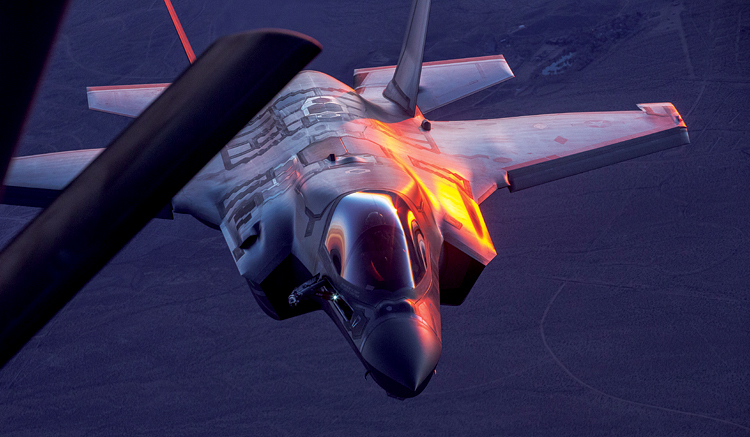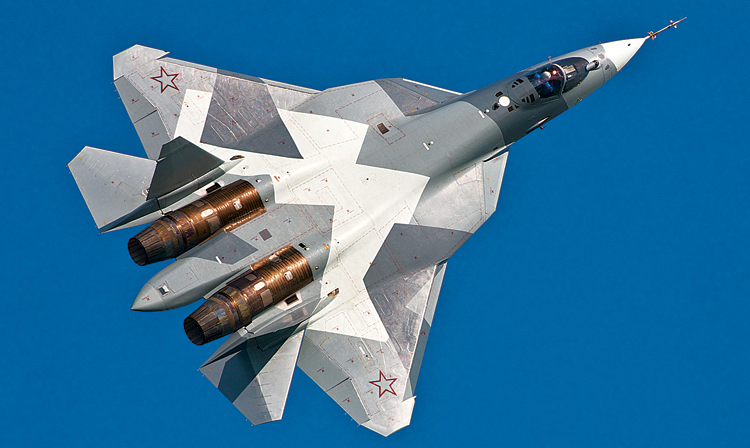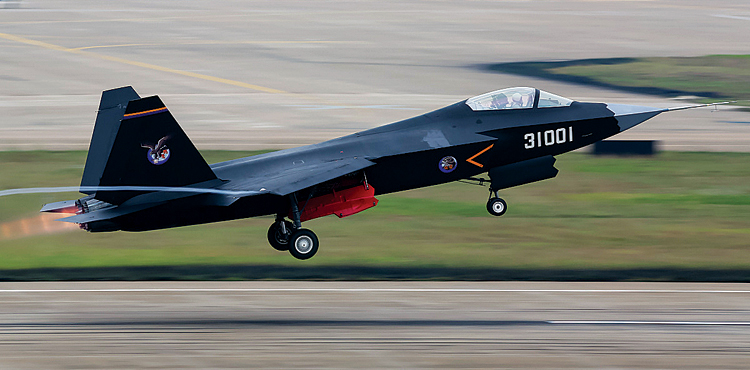INDIAN ARMED FORCES CHIEFS ON
OUR RELENTLESS AND FOCUSED PUBLISHING EFFORTS

SP Guide Publications puts forth a well compiled articulation of issues, pursuits and accomplishments of the Indian Army, over the years

I am confident that SP Guide Publications would continue to inform, inspire and influence.

My compliments to SP Guide Publications for informative and credible reportage on contemporary aerospace issues over the past six decades.
5th Gen Fighters, Stealthy & Lethal
Fifth-generation fighter aircraft are known for stealth, precision attack capabilities, speed, agility and situational awareness which makes a huge difference in the battle-space

Fifth-generation fighters in service or with flying prototypes
| Aircraft | F-22 | F-35A | F-35B | F-35C | Sukhoi PAK FA | J-20 | FC-31 |
| Primary Builder | US | US | US | US | Russia | China | China |
| First flight | 1997 | 2006 | 2008 | 2010 | 2010 | 2011 | 2012 |
| Status | In Service | In Service | In Service | Testing | Testing | In Service (LRIP) | Testing |
| Service date | 2005 | 2016 | 2015 | 2018 | 2018 | 2017 | – |
| Length m | 18.90 | 15.7 | 15.6 | 15.7 | 19.80 | 20.4 | 17.3 |
| Wingspan m | 13.56 | 10.70 | 10.70 | 13.10 | 13.95 | 13.5 | 11.5 |
| Wing area sq. m | 78.04 | 42.70 | 42.70 | 62.10 | 78.80 | 78.00 | – |
| Empty weight | 19,700 kg | 29,300 lb | 32,300 lb | 34,800 lb | 18,000 kg | 19,390 kg | – |
| Loaded weight | 29,410 kg | 22,470 kg | – | – | 29,270 kg | 32,090 kg | – |
| Max takeoff weight | 38,000 kg | 31,800 kg | 27,300 kg | 31,800 kg | 35,000 kg | 36,288 kg | 28,000 kg |
| Takeoff | CTOL | CTOL | STOVL | CATOBAR | CTOL | CTOL | CTOL |
Fighter aircraft are continuously evolving and there is already talk of ‘sixth-generation’, though they may not be up in the skies until the 2030s. Meanwhile, ‘fifth-generation’ aircraft are going strong, including those in the development stages. Presently, Lockheed Martin F-22 Raptor which entered service with the United States Air Force (USAF) in 2005, the Lockheed Martin F-35B Lightning II, which entered service with the US Marine Corps in 2015. the Lockheed Martin F-35A Lightning II, which entered service with the USAF in 2016 and the Chinese Chengdu J-20 which entered service with the People’s Liberation Army Air Force (PLAAF) in March this year, are already showing their prowess in different kinds of deployment. Meanwhile, the Lockheed Martin F-35C Lightning II, Sukhoi PAK FA, Hindustan Aeronautics Limited (HAL) Advanced Medium Combat Aircraft (AMCA), Shenyang J-31 and Mitsubishi X-2 Shinshin, are under various stages of development.
F-22 Raptor First Off the Block
The F-22 Raptor was the first of the fifth-generation to showcase air superiority platform. It has a unique combination of stealth, speed, agility and situational awareness, combined with lethal long-range air-to-air and air-to-ground weaponry. The aircraft has demonstrated precision attack capabilities, decimating both air and ground-based targets with unparalleled lethality and survivability. The F-22 is leading US AF transformation efforts. Its ability to penetrate airspace, while finding, tracking and targeting enemy air and ground-based threats, helps all joint forces. The Raptor’s unique combination of advanced stealth, super cruise, advanced maneuverability and integrated avionics allows it to “kick down the door,” and then follow up with 24-hour stealth operations and freedom of movement for all followon forces – fully leveraging the Raptor’s technological advantages. Lockheed Martin continues to upgrade the aircraft for it to stay lethal and ensure superiority.

F-35 Lightning II, Lightning Indeed
Also from Lockheed Martin, the F-35 Lightning II combines advanced stealth with speed and agility, fully fused sensor information, network-enabled operations and advanced sustainment. Three variants of the F-35 will replace legacy fighters of the USAF, the US Navy, the US Marine Corps and ten other countries. The F-35 family includes three variants, all single-seat jets: the F-35A conventional takeoff and landing (CTOL), the F-35B short takeoff/ vertical landing (STOVL) and the F-35C carrier variant (CV). The F-35 characteristics include advanced stealth, integrated avionics, sensor fusion an d the most powerful and comprehensive integrated sensor package of any fighter aircraft in history. The F-35’s advanced stealth allows pilots to penetrate areas without being detected by radars that legacy fighters cannot evade.
The F-35 is designed with the entire battle-space in mind, bringing new flexibility and capability to the US and its allies. Missions traditionally performed by specialised aircraft — air-to-air combat, air-to-ground strike, electronic attack, intelligence, surveillance and reconnaissance, can now be executed by a squadron of F-35s.

The F-35 is designed with the entire battle-space in mind, bringing new flexibility and capability to the US and its allies. Missions traditionally performed by specialised aircraft — air-to-air combat, air-to-ground strike, electronic attack, intelligence, surveillance and reconnaissance, can now be executed by a squadron of F-35s.
Advanced electronic warfare capabilities enable F-35 pilots to locate and track enemy forces, jam radars and disrupt attacks with unparalleled effectiveness. Advanced avionics give the pilot real-time access to battle space information with 360-degree coverage and an unparalleled ability to dominate the tactical environment. Data collected by sensors on the F-35 can be immediately shared with commanders at sea, in the air or on the ground, providing an instantaneous, high-fidelity view of ongoing operations, making the F-35 a formidable force multiplier while enhancing coalition operations. This system allows F-35 pilots to reach well-defended targets and suppress enemy radars.
THE F-35 LIGHTNING II WAS DESIGNED TO BE AN AFFORDABLE FIFTH-GENERATION FIGHTER, TAKING ADVANTAGE OF ECONOMIES OF SCALE AND COMMONALITIES BETWEEN THE THREE VARIANTS
The F-35’s very low-observable stealth allows it to safely enter defended airspace without being seen by radars that fourth-generation and earlier legacy fighters cannot evade. The combination of the stealth features, active electronicallyscanned array (AESA) radar technology and the aircraft’s ability to carry its full component of weapons stores and fuel internally, allows F-35 pilots to engage ground targets at longer ranges without being detected and tracked, using precision-guided munitions and radar-guided missiles to successfully complete air-toground missions. The F-35 will enter the air battle-space first, clearing the way with air dominance for follow-on legacy fighters to operate with relative impunity.
The F-35’s integrated sensors, information and weapons systems give pilots an advantage over potential threat from front-line fighter aircraft. Compared to fiftth-generation fighters like the F-35 and F-22, legacy aircraft have a larger radar cross-section which means they can be more easily detected by enemy radar. In aerial combat, legacy aircraft have relatively equal opportunities to detect and engage one another, while a pilot of a fiftth generation fighter aircraft can see enemy aircraft first and take decisive lethal action from a stand-off distance. The ability to see and not be seen is redefining previous generation air-to-air tactics.
Interoperability
When it comes to having a ‘quarterback’ for the coalition joint strike force, the inter-operable F-35 is clearly the aircraft for the leadership role. The F-35 is designed to share everything it can see with other aircraft and operation centres to expand situational awareness across the entire network of aircraft. F-35s can support legacy aircraft as well as other F-35s, to achieve mission success and survivability using a combination of stealth, electronic attack, information sharing and other measures.
The F-35 Lightning II was designed to be an affordable fifth-generation fighter, taking advantage of economies of scale and commonalities between the three variants. Since the first F-35 was built, production costs have dropped approximately 60 per cent. The most recent low rate initial production (LRIP) 10 contract reflects an average airframe unit cost approximately eight per cent lower than the LRIP 9 contract signed in 2016 and an approximate 62 per cent reduction since LRIP 1.
China’s Chengdu J-20
By the late 1990s, several Chinese fifth-generation fighter programmes, grouped under the codename J-XX , were identified by Western intelligence. By late 2010, two prototypes of the Chengdu J-20 were undergoing high-speed taxi trials. The J-20 made its first flight on January 11, 2011. On December 26, 2015, a new J-20 with serial number 2101 was seen leaving its Chengdu Aviation Corporation factory. It is believed to be the first of the LRIP aircraft numbered 2101 that conducted its maiden flight on January 18, 2016.The Chengdu J-20 is a stealth, twin-jet, fifth-generation fighter developed by Chengdu Aerospace Corporation for the PLAAF. The J-20 received initial operational clearance in March 2017.

Also China’s Shenyang Aircraft Corporation is working on FC-31/J-31 stealth fighter, which is roughly the same size as the F-35, with a range of 775 miles, a maximum takeoff weight of 28 tonnes and a Mach 1.8 top speed. If it enters service, it would replace single-engine J-10s as a medium fighter with stealth features.
Sukhoi T-50 PAK FA
In the late 1980s, the Soviet Union outlined the need for a nextgeneration aircraft to replace the fourth-generation jet Mikoyan MiG-29 and Sukhoi Su-27 in service. Two projects were proposed to meet this need: the 4.5 generation Sukhoi Su-47 and Mikoyan Project1.44 in 2002. Sukhoi was chosen to lead the design for the new combat aircraft. As the first post-Soviet fighter, the fifth-generation jet fighter Sukhoi PAK FA incorporates technology from both the Su-47 and the MiG 1.44 and when fully developed, it is intended to replace the MiG-29 and Su-27 in the Russian inventory. The PAK FA is designed to compete against the F-22 Raptor and F-35 Lightning II. It performed its maiden flight on January 29, 2010 and the first production aircraft is slated for delivery to the Russian Air Force by 2017. Russia is also developing a lightweight, stealth, multirole fighter, the Mikoyan LMFS (MiG 1-270) (MiG-1.27). This jet fighter is based on the cancelled MiG 1.44 project.
India Also on Horizon
India is independently developing a twin-engine fifth-generation super maneuverable stealth multirole fighter, the AMCA. It is being designed by the Aeronautical Development Agency and will be manufactured by HAL. The Defence Research Development Organisation (DRDO) defines AMCA as a “fifth-generationplus platform”. Unofficial design work on the AMCA began in 2008, while official work started in 2011 and finished in 2014. The first flight is scheduled for 2023–2024. It is a multirole combat aircraft designed for air superiority, strike and other types of roles. It combines super cruise, stealth, advanced AESA radar, super maneuverability and advanced avionics to overcome and suppress previous generation fighter aircraft along with ground and marine defences. The fifth-generation aircraft is intended to be the successor to the SEPECAT Jaguar, Dassault Mirage 2000 and MiG-27 in the Indian Air Force (IAF).
Another joint project of India and Russia is the Sukhoi/HAL Fifth-Generation Fighter Aircraft (FGFA). It is a derivative of the PAK FA T-50 being developed for the Russian Air Force. FGFA was the earlier designation for the Indian version, while the combined project is now called the Perspective Multi-Role Fighter. The FGFA will include a total of 43 improvements over the T-50, including stealth, super-cruise, advanced sensors, networking and combat avionics. But the project is running way behind schedule. In January 2016, it was reported that Russia and India had agreed to continue to develop FGFA and lower investment cost to $4 billion for each nation. They will invest $1 billion in the first year and another $500 million per year for the following six years. The IAF plans to induct 60 of this platform, down from an earlier estimate of 120.





